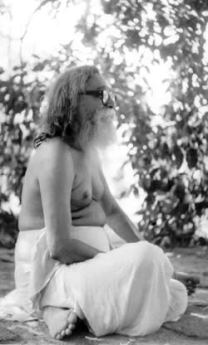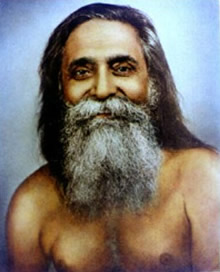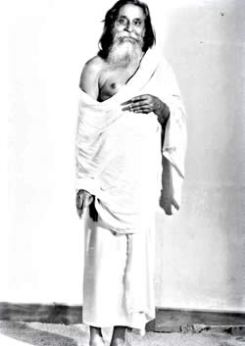
|

Swami Asimananda Saraswati (Thakur) |

|
Gosaiji | Darveshji | Thakur |
A brief introduction of Swami Asimananda Saraswati (Thakur)Swami Asimananda Saraswati Maharaj occupies a very special position among the great men who were sadgurus in the successive order of the famous saint of Bengal, Sadguru Shree Shree Bijoykrishna Goswami. It is extremely rare to find the presence of so many faculties in one single self like him. In his younger days he was a freedom fighter, being a beloved associate of Netaji Subhash Chandra Bose, a political and social activist, an orator, a litterateur, a poet, a Philanthropist, a renunciate house holder and in his later years – a saint, who as sadguru brought place to innumerable souls. His love for the downtrodden knew no bounds. He stood like a rock against injustice. Pre-monastic name of Swami Asimananda Saraswati was Anandaprasad or Annadakumar. His father was Jugal Kishore Chakraborty, a very truthful, honest and strong willed spiritual person, and his mother was Rajani Devi, a deeply kind hearted pious housewife. Annada Kumar was born on 15th February 1904 AD (Falgoon 3, 1310 Bengali Calendar) on the day of Mahashivaratri early in the morning at a Village called Ramchandrapur of Purulia district in West Bengal. The nearest railway station of Ramchandrapur is Muradi, in the South Eastern Railway, almost 260 km from Kolkata. Anandaprasad had his primary education in the village school itself. In protest against the celebration that was taking place in all the schools on the occasion of the arrival of King George V in India, Anandaprasad refused to join. He wrote a poem in Bengali, The English translation of which is as given below. It may be mentioned that he was only eight year of age then. "Those who have cut the fingers of our poor weavers, I will not raise victory slogans in favour of these murderers, even if I have to lose my life for this. For whom have you decorated your roads and for whom are you rejoining by beating drums in favour of George the fifth, as a foreign ruler. What is the need for praising him? You should be ashamed of your conduct of praising the victory of a foreign ruler, who rules over your own country. Today is not a day of joy for us, but a day of mourning. My mother has taught me that they are not friends of our country, but enemies. How can we tolerate the disgrace that our country is being ruled by foreigners? I feel ashamed to accompany you in the procession. When our own people of this country become rulers, then only our glory will be enhanced. When our country is independent, then only we will organize celebration. My mother has told me that the day we get freedom, we will wear nice dresses in celebration." He received the first lessons on patriotism in his very boyhood from his parents. A significant change in his life was noticed after he concluded his studies in the village Muradi and Ranchi. He lost his mother during this period, yet strangely he used to get his mother’s touch and direction even after her death whenever he encountered any problem. During his stay in Burdwan for studies following his mother’s death he came in contact with some underground revolutionaries and some male and female ascetics whose identities were concealed. During his days as a student he used to earn some money writing ledger in shops, making toys and paper bags or working as a cook in some houses. Managing his personal expenses with such earnings he used to send some money to his father every month for his need. His life was thus built on tough struggle from his early years. During his stay at Burdwan he received a message stating his father’s serious illness. He happened to be penniless that day. He came home and found his father bed ridden. There was no food or medicine at home. His younger sister Prima was starving. Anandaprasad prayed to God beseechingly saying that he would not beg anything from anybody if he himself did not grant something. A sadhu then arrived as a guest that day and wanted to have Prasad there. To quote from his book ‘Amar Jiban’, he said, “I wept and said to the Lord - Oh Lord, what have you done! There is no one else to rescue me from this test ….. I suddenly saw a young lad, brimming with beauty and grace whose charm captivates the mind instantly, seeing whom one feels like lifting him to one’s chest and embracing him, has brought a basket on his head. He said on arriving – "An old man has sent these things for you. He has already paid my charges. Tell me where I should keep these” I thought who could this benevolent old man be. The basket contained atta, a container full of ghee, sugar, sago, barley, sugar candy, fruits and vegetables. I was a bit unmindful. Tears streaming from my eyes flooded my chest. As I became conscious I found neither the lad nor the sadhu." Anandaprasad related everything to his father he started crying on hearing this and said – “My ancestral homestead is blessed today- It has become holy. Just a few days after this incident my father died. Anandaprasad had seen then that the benevolent Gosaiji placed his right foot on father’s head and his father uttered ‘Om Namah Shivaya’ thrice and left his mortal frame. On completion of his father’s shradha ceremony he came back to Burdawan again keeping his sister at his aunt’s (father’s sister) place. He studied up to matriculation. During this period he had come in contact with Kamalakanta, the wandering ascetic, Tibbatibaba, Hamsababa and Annada Thakur (of Adya peeth). He lived in Kolkata for some days during this period. Subsequently he left Kolkata and Burdawan and came to Ramchandrapur installed an ashram at the foot of that old peepul tree and started political work and service to people. Taking help from some softless workers from various villages he started constructive work for the swadeshi movement and service to people. Following this he plunged into non-co operation movement, being inspired by Netaji Subhash Chandra Bose’s ideal and direction. Concurrently with non-violent movement he quietly developed a force of five thousand santhals. He had received sincere support from Mahendra Chakraborty at Jashpur Village. This news did not remain secret. The British became furiously enraged and scared. On the day of Falgoomi Poornima (Full moon day in the month of February – March) in 1928 of a political conference of Manbhum district took place. Netaji Subhash Chandra Bose had come here during this time and stayed here for two days. Under the president ship of Subhashbabu and with the co-operation of Rishi (Sage) Nibaranchandra, thousands of people had joined this conference. The British government on seeing Anandaprasad’s great organizing power, ordered his imprisonment for one year. Soon after being released from the jail he started the organizing activities again. To punish him this time, on the 14th of August 1929, the district magistrate of Purulia Mr. Taylor and Mr. Churcher had a team of eight armed pathan soldiers to Ramchandrapur ashram and inflicted barbaric torture on Anandaprasad. They burnt the ashram’s library to ashe’s. With the help of the pathans, Taylor and Churcher laid him to the horse and dragged him to Mahendra Chakraborty’s house in Jashpur village. On failing to find Mahendra babu they started inflicting in-human torture on Anandaprasad. He became almost lifeless due to the whiplashes, stabbing of bayonets and torturing by the boots. They then tied his near dead body to the hose and made it run. The santhals lost their patience on seeing this. They shot an arrow. Being afraid now Taylor and Churcher threw Anandaprasad’s body on the bank of a pond and left. Nobody from the village approached Anandaprasad at that time out of fear. The santhals picked him up and took him away. Anandaprasad had no sense for three days. Gosaiji and Darveshji Maharaj had saved him during this period. He had received the touch of their affection. That is why he was saved. Following this he stayed with Professor Sharat Chandra Bhattacharya at Hazaribag. He was sentenced to two years rigorous imprisonment after this. He had supernatural darshans of many mahatmas during his stay in the jail. |
|
|
The police followed him all the tins even after his release from the jail. He entered family life on the 6th of June 1932 AD.
Even in his family life he used to stay unattached. He how built a house on his ancestral land. He used to maintain his house hold expenses and service to guests by tailoring clothes, selling khadi fabrics, producing vegetables in the garden etc., on getting inspiration from him, many youths from the village had dedicated themselves to the service of the country. He was found to busy always in the service of some cholera infected villagers or some other service oriented activities, being helped in this, by these selfless workers. For about a year he was kept under observation and restraint, by the police, under a Peepul tree close the Muradi station. He came to Dhanbad in the month of Falgoon of 1347 Bengali calendar (Feb-Mar 1941 AD). He then had a direct darshan of the Mahatma Shree Kiranchand Darveshji Maharaj, whom he had seen earlier in his dream and was blessed by receiving deeksha from him. His life under went a major change following deeksha. He dissolved his personal will and derives completely with that of Shree Gurudev. The ashram was named ‘Shree Shree Bijoykrishna Ashram, according to Darveshji Maharaj’s direction and the service wing was named ‘Shree Shree Bijoykrishna Ashram Relief Society’. He dedicated himself to various service activities like establishing school, cottage industry, charitable dispensary etc. Many lives were saved by the free kitchen conducted by him during the famine of 1943. This huge work of a pauper who lived on the road, drew the attention of many. During the dreadful fire of 1945 and 1946 in Manbhum thousands of families had lost everything. The Relief Society arranged for food, clothes, building houses and served people in various other ways. He had given shelter to nearly three hundred families who had left Noakhali (Now in Bangladesh) leaving every thing behind during the horrible riot. Having taken his assistance for some days, they then made their own arrangement and shifted elsewhere. The Eye hospital was started in January 1952 on Netaji’s inspiration. The work of the hospital grew gradually and permanent building for the hospital was built. Poor people used to get free treatment by Gosaiji’s grace. Hundred percent patients used to get back their full vision following their operation. The name of the ashram thus spread everywhere. He had taken a vow of ‘akashvritti’ (meaning depending totally on God for one’s sustenance). Following his Gurudev's demise he had taken sanyas in the month of Magh (Jan-Feb) of 1947 at Triveni confluence of the three rivers) in Prayag. His name after sanyas became Swami Asimananda Saraswati. After his Gurudev was no more, he gradually mould away from political work and dedicated himself to the spiritual path. Prior to leaving his mortal from Darveshji had given him four boons –
Darveshji had blessed and said then itself – ‘Be a conqueror of everything. Gosaiji showers limitless grace on you’. According to his Gurudev’s instruction Swami Asimanandaji started initiating people after his sanyas. Innumerable people were gratified by getting deeksha from him. There were some specialties in the deeksha he gave, such as –
You will have to cross the ocean of samsar while staying in the samsar itself. Make the samsar itself the ashram of sadhana. Dedicate this house of samsar to the lord’s feet and be the servant. See that supreme being in everybody. Serve him by seeing his in every being. See only that Thakur who is performing his leela while being in parents, husband and wife, son and daughter, brother and friend, relative and non-relative. Worship him, bow down to him. You will them find that the illusion of samsar has disappeared. Thoughts of ‘my’ are the cause of sorrow, there is no grief when you think of it to be belonging to others. We should practice so that we may accept that everything belongs to the lord. May we desist from thinking of this samsar, wealth, men properties, glory, riches, because these are all temporary and can get destroyed now itself, and think of the Supreme Lord who is the ultimate cause of these and who is performing leela while being in all these things. Being unattached and without the sense of ownership to all these, we may do his work with a heart free from grief. God has said “Do only my work. I am the ultimate objective. One who is my bhakta, free from attachment, who has abandoned feelings to enmity everywhere is the one who attains me.” He is everything. He is present in every thing whom can you think to be your enemy? All are friends. My Thakur resides in everybody. The sole purpose of sadhana is to attain this sweet state. (Vide : Letters of Asimananda) He has already expressed in this very letter that this object of sadhan can be attained by performing spiritual practice. This supreme truth had manifested in his life. All of those who had come in contact with him or had seen him were charmed to see his sweet loving bhava. In his mission of Spreading God’s name and on the instructions of Shreeman Mahaprabhu and Shree Gosaiji he had traveled to Vrindavan, Puri and Nabadwip Dham along with a ratha (chariot) while performing naam sankeertan. Innumerable man and women had seen his loving from and were blessed by his grace during this period. Thus he served people till 1968 according to the instruction of his Shree Gurudev. Some of the letters of Darveshji written to Swami Asimananda Maharaj were published in ‘Mandir’ magazine. A section of these letters are quoted below –
He left his mortal frame for his eternal journey on the 13th of August 1968 during Krishna Shadhthi (the sixth day of the dark lunar fortnight).
- Swami Amalananda Saraswati
|
|